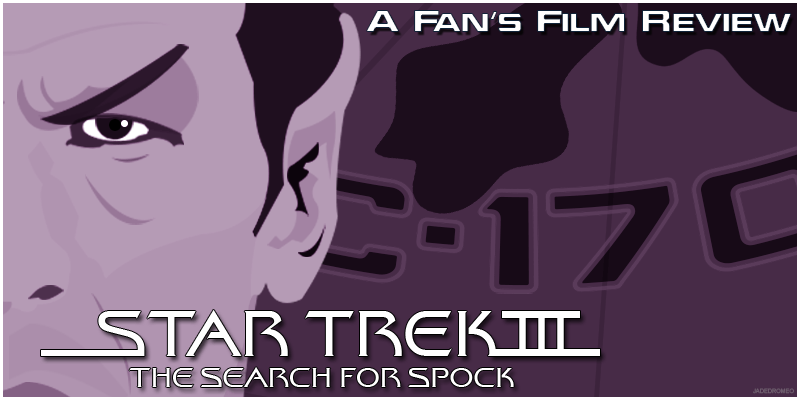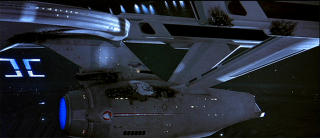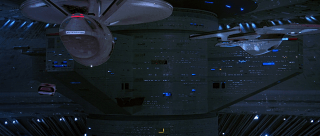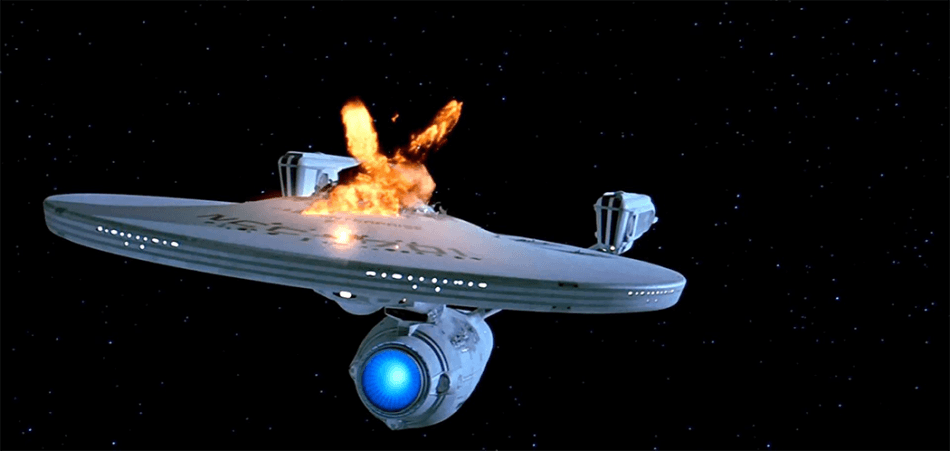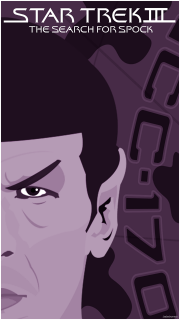 Going to the movies to see The Search for Spock was my reward for passing the fourth grade with a ‘B+’ average. Having seen The Wrath of Khan dozens of times on premium cable movie channels (HBO & Cinemax), I was as eager as anyone for the adventure to continue. I remember getting really excited by a phone conversation with my dad about the upcoming film. (By this time, I was with my mom and stepdad, who was stationed at Homestead Air Force Base in Florida. My dad was based at Tyndall Air Force Base, also in Florida, but more than a ten-hour drive away. I was lucky if my brother and I saw him once a year.) My dad told me of a pretty exciting trailer he saw of the Enterprise having its bridge and half of the saucer blown off and the Klingons were STILL ATTACKING!
Going to the movies to see The Search for Spock was my reward for passing the fourth grade with a ‘B+’ average. Having seen The Wrath of Khan dozens of times on premium cable movie channels (HBO & Cinemax), I was as eager as anyone for the adventure to continue. I remember getting really excited by a phone conversation with my dad about the upcoming film. (By this time, I was with my mom and stepdad, who was stationed at Homestead Air Force Base in Florida. My dad was based at Tyndall Air Force Base, also in Florida, but more than a ten-hour drive away. I was lucky if my brother and I saw him once a year.) My dad told me of a pretty exciting trailer he saw of the Enterprise having its bridge and half of the saucer blown off and the Klingons were STILL ATTACKING!
Needless to say, it was a pretty exciting description. I saw a few TV spots for the film that showed the Enterprise backing out of a massive structure. My mind filled with all kinds of exciting scenarios as to what kind of adventure Kirk and our heroes would be facing in the quest to get Spock back. There was never any question that he would return, the real question was, “Is the search going to be fun?” It definitely looked like it was to me. Finally, I was going to get that battle between the ‘new’ (i.e. refitted) Enterprise that I had fallen in love with and those newly designed Klingons!
Now THAT’S good advertising! I couldn’t wait! Little did I realize that the ball on this film had begun rolling long before I had even seen the previous film on HBO. Harve Bennett, the man credited with bringing Star Trek back to life by killing Spock, was told by the suits at Paramount almost immediately after The Wrath of Khan’s opening weekend, “Start working on Star Trek III!” According to Bennett, it was “the fastest green light [he] ever got on a project.”
Having observed the reactions of the test audience on TWOK and getting to know the cast and the fan base, Bennett knew exactly how this film needed to end and what the theme needed to be; it was just a matter of getting our heroes from where they were at the end of TWOK to the ending that Bennett wanted. So he started at the end and worked his way backwards. The story went through a number of interesting changes along the way, but unlike the previous film, where Bennett had a great deal of trouble finding a good narrative, he evidently found this film quite enjoyable to write, and this time almost single-handedly came up with a story that would expand the Star Trek universe as we had never seen it before.
And who would direct this rip-roaring, universe expanding adventure? After Nick Meyer had turned down the opportunity to direct this film (citing that he didn’t believe in resurrections, though I personally believe he really turned it down because he was against the idea of Spock’s return since any scenes in The Wrath of Khan implying such were done against his wishes), the suits at Paramount discovered there was a talent they had all along…Spock actor himself, Leonard Nimoy.
When asked if he would “like to be involved in any way in the making of Star Trek III”, Nimoy, who long had dreams of directing features, seized the opportunity and said, “Yes. I would like to direct the picture.” He didn’t expect a ‘yes’ answer right away, but the new head of Paramount, Michael Eisner, thought it was a great idea. “I can see it in print now. ‘Leonard Nimoy directs The Return of Spock’. Great Idea!” Although Nimoy almost didn’t get the job due to a slight misunderstanding regarding his contract for TWOK killing Spock off, he nevertheless managed to iron out this wrinkle and try out his wings on becoming the visual author on a feature film.
It wouldn’t be easy. With only a $16 million budget, the studio constantly looking over his shoulder and jealousy issues from his castmates, Nimoy would have to deliver a vision for Bennett’s story that would out-spectacle its predecessor. He did so brilliantly! Since tons of money was being saved making use of the previous two film’s sets, models, and costumes, Nimoy went over several new spaceship designs with Nilo Rodis-Jamero and Bill George at Industrial Light and Magic. Four new designs would be chosen that would prove tremendous eye candy for the latest Star Trek adventure. These were the Klingon Bird of Prey, the U.S.S. Excelsior, the U.S.S. Grissom, and the gargantuan Starfleet orbital spacedock. All of these models would make their way into many Star Trek productions to come.
And what kind of a ‘return of Spock’ story would be epic enough to warrant such an expansion of the Star Trek universe? Kirk himself spells it out quite clearly; this would be a story about loyalty and sacrifice, about friendship and brotherhood. In the last film, Spock gave his life so that the Enterprise and her crew would live. In this film, Kirk and company would sacrifice everything short of their lives to give Spock another chance.
And what about the destruction of my favourite spaceship of all time? Surprisingly, I wasn’t bothered by it. Don’t get me wrong; par for the damage from the previous film, the Enterprise never looked lovelier, thanks to the colourful cinematography of Charles Correll. Even crippled as she was and facing decommission, she gave her all for Spock as much as any of the other characters.
This is best demonstrated in the sequence where the crew steals her back in their effort to violate Starfleet’s quarantine on the Genesis Planet. When the Enterprise begins to back out at one-quarter impulse power, we hear the same musical cue that James Horner gave us when she started backing away from Reliant in the previous film. However, where the musical cue spoke of the Enterprise’s desperation to get away from Reliant the first time we heard it, this time it speaks of her determination. We also finally get the fight that I’ve always wanted to see between the Enterprise and Klingons and her torpedoes kick ass before her crippled systems finally give after everything she’s been through. Scuttling the ship has become the only option left and before the crew departs through the transporter one final time, they reappear for a split second as the transport beams close on them. Was this her way of giving them a goodbye hug? I’ve always liked to think so.
But even after the ship was gone, I realized something with this film that my young mind had not yet perceived before. The Enterprise actually still lived on…through her crew. It was with this film that I first began to realize that it wasn’t the ship, the neat technology, or cool space battles that really mattered…it was these people, the crew who had by this time become an extended part of my dad’s side of the family. It was with this film that the entire cast was truly utilized for the first time. This no doubt went a long way towards resolving any jealousy issues that the rest of the cast might have been feeling towards Nimoy in the beginning.
He truly understood that Star Trek had by this time become an ensemble piece, with the entire group of seven, not just the Big Three of Kirk, Spock, & McCoy, as a larger family. Never before was this better shown than when the others wait in the wings, like a family in a hospital waiting room, while Spock and McCoy undergo the fal-tor-pan to bring our beloved Vulcan back. When I had the pleasure of meeting James Doohan at a convention in Ft. Myers, Florida in 1996 and a fan asked who was the best director they had ever had, Doohan said, “Leonard, easily!”
As with the previous film, the performances are top-notch. William Shatner, in particular, evokes our sympathy as never before upon learning of the death of Kirk’s son at the hands of the Klingon Commander Kruge. Not even the death of his wife, Miramanee, or even Spock’s death evoked such a strong reaction from him.
As for Kruge, the villain of the piece, Christopher Lloyd’s performance arguably elevates the role to more than it was written. However, it should be noted that Kruge’s sense of honour, while twisted in his case, made him and his crew the template by which all other Klingon characters since then have been based. The emphasis on honour for the first time made the Klingons more than token villains and paved the way for future Klingon characters that we would eventually actually cheer for…such as Worf and Martok.
With all of these cool new spaceships, terrific cinematography, and music from James Horner that was actually even better than his work on TWOK, The Search for Spock not only gave me the spectacle I was craving coming out of fourth grade, it touched my heart in a way that I did not anticipate, thanks to a brilliant decision by Harve Bennett to carry on The Wrath of Khan’s themes by turning them on their head. Spock sacrificed himself because the needs of the many outweighed the needs f the few. When he asks Kirk why he would sacrifice everything to come back for him, Kirk’s response is as succinct as it is heartfelt. “Because the needs of the one outweighed the needs of the many.”
The film ends with a tremendous triumph of Spock’s return and the caption, “…and the adventure continues…” leaving us with warm hearts and an inability to wait for Star Trek IV. Wonderfully written, masterfully executed, and brilliantly scored…it’s not only a great Star Trek movie, it’s one of my favourite films of all time. I give Star Trek III: The Search for Spock a heartfelt 10 on the 1-to-10 scale.
[one-fifth-first][/one-fifth-first]
[one-fifth][/one-fifth]
[one-fifth][/one-fifth]
[one-fifth][/one-fifth]
[one-fifth][/one-fifth][clearfix]
» Video media: YouTube (Videos link directly to sources) Images: CBS/Paramount, “Special Thanks” to David Klawitter, (Featured Image and Poster Art are shown under exclusive rights granted by the artist)

